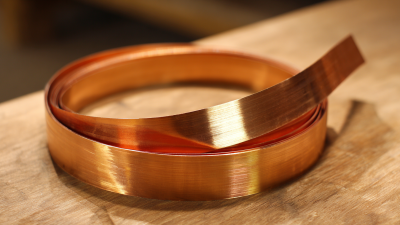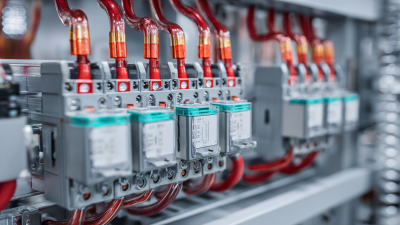Understanding the Efficiency of Composite Busbars in Modern Electrical Systems
Table of Contents
- How to Identify the Key Advantages of Composite Busbars in Electrical Systems
- How to Evaluate the Performance Metrics of Composite Busbars
- How to Select the Right Composite Busbar for Your Application
- How to Optimize the Installation Process of Composite Busbars
- How to Ensure Long-Term Reliability of Composite Busbars in Operations
- FAQS
- Conclusion
- Related Posts
In today’s fast-changing world of electrical systems, making power distribution efficient is more important than ever. One key player in boosting that efficiency is the Composite Busbar. These innovative components are pretty impressive—they’re lightweight but still super sturdy, which helps ensure electricity flows smoothly while cutting down on energy losses.

A company that’s really leading the charge in this area is Sichuan D&F Electric Co., Ltd. They’ve been around since 2005, specializing in electrical connection parts and insulation components. Their headquarters is nestled in the beautiful Jinshan Industrial Park, right inside the Luojiang Economic Development Zone in Deyang, Sichuan, China. D&F Electric is all about pushing the boundaries with top-notch solutions that include those advanced Composite Busbars.
When you really understand how these systems work and their benefits, it’s easier for businesses to make smarter choices—improving not just their electrical setup but also their overall performance.
How to Identify the Key Advantages of Composite Busbars in Electrical Systems
You know, composite busbars are really turning into a game-changer in modern electrical setups. They come with quite a few perks that boost efficiency and overall performance. Basically, these busbars are usually made by combining materials like copper or aluminum with insulation layers, and get this—they can be up to 80% lighter than traditional metal ones. That's a pretty big deal because it makes handling and installing them way easier (according to the International Energy Agency back in 2021).

How to Evaluate the Performance Metrics of Composite Busbars
When you're looking at how well composite busbars perform in today's electrical setups, there are a few key things you really want to pay attention to. First off, conductivity is huge—it's basically how well the material can carry electricity, which directly affects both efficiency and how good the system is at managing heat. The cool thing about composite materials is that they often have better conductivity than the traditional kinds, which means less energy lost along the way and a more reliable system overall.
Here’s a quick tip: when you're picking out composite busbars, it’s smart to run a thermal analysis. You want to make sure the materials can handle the heat they’ll generate during operation. It’s a simple step that can boost their lifespan and keep things safe.
Another essential factor is mechanical strength. These busbars need to stand up to all sorts of stresses—thermal cycles, vibrations, you name it. Checking their tensile strength and how well they resist fatigue can give you peace of mind that they’ll keep working properly over time, even in tough conditions.
And here’s a tip: look for options that come with certifications or reviews highlighting their durability. Trust me, that kind of reassurance can go a long way, especially when you're dealing with critical infrastructure or any heavy-duty application.
How to Select the Right Composite Busbar for Your Application
When you're trying to pick the right composite busbar for your project, a few key things really matter—like how well it conducts electricity, how much it weighs, and how it handles heat. You know, recent industry reports actually show that these composite busbars can be up to 30% lighter than the traditional copper ones. That’s a pretty big deal because it means easier installation and more flexibility when designing structures. Plus, cutting down on weight often means saving on installation costs and boosting energy efficiency, which makes composite options pretty attractive for modern electrical setups.
On top of that, thermal performance is super important too. Recent market data suggests that composite materials can handle higher temperatures without breaking a sweat, which helps electrical systems last longer. And the best part? You can often customize these busbars to fit specific needs, making them super versatile for different environments. So, understanding all these factors can really help engineers and electricians make smarter choices, leading to more efficient and reliable electrical systems in today’s demanding world.
Understanding the Efficiency of Composite Busbars in Modern Electrical Systems - How to Select the Right Composite Busbar for Your Application
| Busbar Type | Conductivity (S/m) | Weight (kg/m) | Current Rating (A) | Corrosion Resistance |
|---|---|---|---|---|
| Aluminum Composite Busbar | 35.0 | 2.5 | 800 | Good |
| Copper Composite Busbar | 58.0 | 4.5 | 1000 | Excellent |
| Steel Composite Busbar | 10.0 | 6.0 | 600 | Fair |
| Hybrid Composite Busbar | 45.0 | 3.5 | 900 | Very Good |
How to Optimize the Installation Process of Composite Busbars
When it comes to installing composite busbars, making the process smoother and more efficient is pretty important for modern electrical setups. One of the first things to focus on is good planning and design. Before jumping into installation, electrical engineers really need to double-check that everything lines up with the system’s needs. Using 3D modeling software can be a huge help—it lets you visualize how everything will sit together, catch potential measurement errors early, and make the whole process way more precise.
Another big piece of the puzzle is training the team properly. It’s crucial that technicians understand what makes composite materials special. For example, they’re lighter than traditional metals, which makes handling and installing them a lot easier and faster. Plus, technicians should be familiar with the right tools and techniques—handling composites the wrong way can actually cause damage or slow things down.
And don’t forget about modular installation methods! Pre-assembling parts in a controlled environment can really speed things up on-site. Not only does this save time, but it also means the install quality tends to be better, since everything gets tested and assembled under ideal conditions before actually being put into the system.

How to Ensure Long-Term Reliability of Composite Busbars in Operations
You know, composite busbars have really become a key part of modern electrical setups these days. They strike a pretty good balance between efficiency and reliability. But to keep them running smoothly over the long haul, it’s super important to do regular check-ups and maintenance. Things like watching out for signs of wear and tear, thermal expansion, or even corrosion can make a big difference because these issues can really mess with how well the composite materials work. Setting up a preventive maintenance routine is a smart move—it helps catch problems early on, so you can fix them before they turn into bigger, more expensive issues. That way, you’re basically giving these busbars a longer life span.
Also, choosing the right composite materials isn’t something to take lightly. Picking materials that can handle high temperatures and electrical loads will seriously boost their durability and lower the chances of failure down the road. It’s a good idea to work closely with manufacturers to get a solid understanding of what these materials can and can't handle—because knowing that stuff helps you design systems that keep things up and running as much as possible. And don’t forget about the folks handling these busbars—making sure they’re trained on how to properly handle and install them can really save you from damage or issues later on. All these little steps add up and help keep things running smoothly over time.
Understanding the Efficiency of Composite Busbars in Modern Electrical Systems
This chart illustrates the efficiency of composite busbars compared to traditional copper and aluminum busbars in modern electrical systems. The data represents energy losses in percentage over various operational conditions.
FAQS
: Composite busbars are significantly lighter, up to 80% less than traditional metal busbars, while maintaining similar or superior current-carrying capacities. They also provide excellent electrical insulation, enhancing safety and energy efficiency by approximately 30% due to lower thermal expansion and corrosion resistance.
Optimizing installation involves meticulous planning and design using 3D modeling software for accurate visualization and measurement. Additionally, training technicians on the unique characteristics of composite materials and employing modular installation techniques can significantly improve installation efficiency.
Training ensures that technicians understand the lighter weight and specific handling techniques necessary for composite busbars, minimizing the risk of damage during installation and improving overall efficiency and safety.
Modular installation techniques involve pre-fabricating busbar sections in a controlled environment, which can streamline the on-site installation process, shorten project timelines, and enhance installation quality.
Ensuring long-term reliability involves regular inspections and maintenance to monitor for wear, thermal expansion, and corrosion. Implementing a preventative maintenance schedule can address issues early and prolong the busbars' lifespan.
The choice of composite materials that can withstand high thermal and electrical loads enhances durability. Additionally, training personnel on the properties and handling techniques of composite busbars minimizes damage and supports consistent performance.
Composite materials offer excellent dielectric properties that provide superior electrical insulation, reducing the risk of short circuits and improving the overall safety of electrical systems.
The lighter weight of composite busbars facilitates easier handling and faster installation times compared to traditional metal busbars, allowing for more efficient project execution.
Regular maintenance should monitor for signs of wear and tear, corrosion, thermal expansion, and other potential issues that could affect the performance and reliability of composite busbars.
Collaborating with manufacturers helps engineers understand the specific characteristics and limits of composite materials, ensuring the design of systems that maximize uptime and reliability.
Conclusion
So, I recently read this article called 'Understanding the Efficiency of Composite Busbars in Modern Electrical Systems,' and honestly, it was pretty eye-opening. It dives into all the major perks of using composite busbars in electrical setups. Basically, it shows how these components can boost efficiency by delivering top-notch performance, which is probably why they're becoming the go-to choice nowadays. The article isn’t just listing benefits, though; it also offers some good tips on how to pick the right ones for your specific needs, evaluate their performance, and make smart choices to match your project.
Plus, it stresses how important it is to get the installation right and keep things reliable over time. For companies like Sichuan D&F Electric Co., Ltd., who deal with electrical connection parts, jumping on the composite busbar train can seriously upgrade their product lineup and make their systems run smoother and more efficiently. Overall, it’s a solid read if you're into optimizing electrical systems or just want to stay updated on the latest tech out there.
Related Posts
-

The Future of High Temperature Insulation Board in Sustainable Construction
-

How to Choose the Right Flexible Copper Strip for Optimal Electrical Performance
-

The Ultimate Guide to Understanding Smc Sheets and Their Applications in Modern Industries
-

Exploring Insulation Class H Innovations at the 138th China Import and Export Fair 2025
-

How to Choose the Right Flexible Busbar Solutions for Your Industrial Needs
-

How to Choose the Right Nomex Paper for Your Business Needs in China









